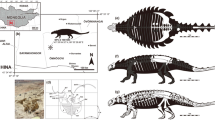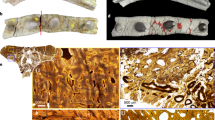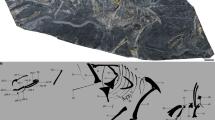Abstract
Numerous feathered dinosaur specimens have recently been recovered from the Middle–Upper Jurassic and Lower Cretaceous deposits of northeastern China, but most of them represent small animals1. Here we report the discovery of a gigantic new basal tyrannosauroid, Yutyrannus huali gen. et sp. nov., based on three nearly complete skeletons representing two distinct ontogenetic stages from the Lower Cretaceous Yixian Formation of Liaoning Province, China. Y. huali shares some features, particularly of the cranium, with derived tyrannosauroids2,3, but is similar to other basal tyrannosauroids4,5,6,7,8,9,10,11,12 in possessing a three-fingered manus and a typical theropod pes. Morphometric analysis suggests that Y. huali differed from tyrannosaurids in its growth strategy13,14. Most significantly, Y. huali bears long filamentous feathers, thus providing direct evidence for the presence of extensively feathered gigantic dinosaurs and offering new insights into early feather evolution.
This is a preview of subscription content, access via your institution
Access options
Subscribe to this journal
Receive 51 print issues and online access
$199.00 per year
only $3.90 per issue
Buy this article
- Purchase on SpringerLink
- Instant access to full article PDF
Prices may be subject to local taxes which are calculated during checkout



Similar content being viewed by others
References
Xu, X. & Guo, Y. The origin and early evolution of feathers: insights from recent paleontological and neontological data. Vert. PalAsiatica 47, 311–329 (2009)
Holtz, T. R. in The Dinosauria 2nd edn (eds Weishampel, D.B., Dodson, P. & Osmólska, H. ) 111–136 (Univ. California Press, Berkeley, 2004)
Currie, P. J. Cranial anatomy of tyrannosaurid dinosaurs from the Late Cretaceous of Alberta, Canada. Acta Palaeontol. Pol. 48, 191–226 (2003)
Rauhut, O. W. M., Milner, A. C. & Moore-Fay, S. Cranial osteology and phylogenetic position of the theropod dinosaur Proceratosaurus bradleyi (Woodward, 1910) from the Middle Jurassic of England. Zool. J. Linn. Soc. 158, 155–195 (2010)
Rauhut, O. W. M. A tyrannosauroid dinosaur from the Upper Jurassic of Portugal. Palaeontology 46, 903–910 (2003)
Xu, X. et al. Basal tyrannosauroids from China and evidence for protofeathers in tyrannosauroids. Nature 431, 680–684 (2004)
Xu, X. et al. A basal tyrannosauroid dinosaur from the Late Jurassic of China. Nature 439, 715–718 (2006)
Ji, Q., Ji, S. A. & Zhang, L. J. First known large tyrannosauroid theropod from the Early Cretaceous Jehol Biota in northeastern China. Geol. Bull. China 28, 1369–1374 (2009)
Li, D. Q., Norell, M. A., Gao, K.-Q., Smith, N. D. & Makovicky, P. J. A longisrostrine tyrannosauroid from the Early Cretaceous of China. Proc. R. Soc. Lond. B 277, 183–190 (2010)
Averianov, A. O., Krasnolutskii, S. A. & Ivantsov, S. V. A new basal coelurosaur (Dinosauria: Theropoda) from the Middle Jurassic of Siberia. Proc. Zool. Inst. RAS 314, 42–57 (2010)
Benson, R. B. J. New information on Stokesosaurus, a tyrannosauroid (Dinosauria: Theropoda) from North America and the United Kingdom. J. Vertebr. Paleontol. 28, 732–750 (2008)
Hutt, S., Naish, D., Martill, D. M., Barker, M. J. & Newbery, P. A preliminary account of a new tyrannosauroid theropod from the Wessex Formation (Early Cretaceous) of southern England. Cretac. Res. 22, 227–242 (2001)
Erickson, G. M. et al. Gigantism and comparative life-history parameters of tyrannosaurid dinosaurs. Nature 430, 772–775 (2004)
Currie, P. J. Allometric growth in tyrannosaurids (Dinosauria: Theropoda) from the Upper Cretaceous of North America and Asia. Can. J. Earth Sci. 40, 651–665 (2003)
Brusatte, S. et al. Tyrannosaur paleobiology: new research on ancient exemplar organisms. Science 329, 1481–1485 (2010)
Sereno, P. C. et al. Tyrannosaurid skeletal design first evolved at small body size. Science 326, 418–422 (2009)
Fowler, D. W., Woodward, H. N., Freedman, E. A., Larson, P. L. & Horner, J. R. Reanalysis of ‘Raptorex kriegsteini’: a juvenile tyrannosaurid dinosaur from Mongolia. PLoS ONE 6, e21376 (2011)
Swisher, C. C. et al. Further Support for a Cretaceous age for the feathered-dinosaur beds of Liaoning, China: New 40Ar/39Ar dating of the Yixian and Tuchengzi Formations. Chin. Sci. Bull. 47, 135–138 (2002)
Christiansen, P. & Fariña, R. A. Mass prediction in theropod dinosaurs. Hist. Biol. 16, 85–92 (2004)
Ortega, F., Escaso, F. & Sanz, J. L. A bizarre, humped Carcharodontosauria (Theropoda) from the Lower Cretaceous of Spain. Nature 467, 203–206 (2010)
Brochu, C. A. Osteology of Tyrannosaurus rex: insights from a nearly complete skeleton and high-resolution computed tomographic analysis of the skull. J. Vertebr. Paleontol. Mem. 7, 1–138 (2003)
Brusatte, S. L., Carr, T. D., Erickson, B. R., Bever, G. S. & Norell, M. A. A long-snouted, multihorned tyrannosaurid from the late Cretaceous of Mongolia. Proc. Natl Acad. Sci. USA 106, 17261–17266 (2009)
Xu, X., Tang, Q.-W., Wang, J.-M., Zhao, X.-J. & Tan, L. A gigantic bird-like dinosaur from the late Cretaceous of China. Nature 447, 844–847 (2007)
Xu, X., Tang, Z.-L. & Wang, X.-L. A therizinosauroid dinosaur with integumentary structures from China. Nature 399, 350–354 (1999)
Paul, G. S. in Tyrannosaurus rex, the Tyrant King (eds Carpenter, K. & Larson, P.E. ) 354–368 (Indiana Univ. Press, 2008)
Currie, P. J., Badamgarav, D. & Koppelhus, E. B. The first Late Cretaceous footprints from the Nemegt Locality in the Gobi of Mongolia. Ichnos 10, 1–13 (2003)
Amiot, R. et al. Oxygen isotopes of east Asian dinosaurs reveal exceptionally cold Early Cretaceous Climates. Proc. Natl Acad. Sci. USA 108, 5179–5183 (2011)
Fiorillo, A. R. & Gangloff, R. A. Theropod teeth from the Prince Creek Formation (Cretaceous) of northern Alaska, with speculations on Arctic dinosaur paleoecology. J. Vertebr. Paleontol. 20, 675–682 (2000)
Spicer, R. A. & Herman, A. B. The Late Cretaceous environment of the Arctic: a quantitative reassessment based on plant fossils. Paleogeogr. Palaeoclimatol. Palaeoecol. 295, 423–442 (2010)
Deng, T. et al. Out of Tibet: Pliocene woolly rhino suggests high-plateau origin of ice age megaherbivores. Science 333, 1285–1288 (2011)
Acknowledgements
We thank L. Zhang for discussions, R. Li, H. Zang and X. Ding for illustrations, and H. Wang, L. Xiang and R. Cao for preparing the specimens. We thank the Zhucheng Municipal Government and Erlianhaote Municipal Government for support. This study was supported by grants from the National Natural Science Foundation of China and Special Funds For Major State Basic Research Projects of China.
Author information
Authors and Affiliations
Contributions
X.X. designed the project. X.X., K.W., K.Z., Q.M., L.X., C.S., D.H., S.C. and S.W. performed the research. X.X., C.S. and Q.M. wrote the manuscript.
Corresponding author
Ethics declarations
Competing interests
The authors declare no competing financial interests.
Supplementary information
Supplementary Information
This file contains Supplementary Text 1-6 (see page 1 for details), Supplementary Figures 1-6, Supplementary Tables 1-2 and additional references. (PDF 938 kb)
Rights and permissions
About this article
Cite this article
Xu, X., Wang, K., Zhang, K. et al. A gigantic feathered dinosaur from the Lower Cretaceous of China. Nature 484, 92–95 (2012). https://doi.org/10.1038/nature10906
Received:
Accepted:
Published:
Issue Date:
DOI: https://doi.org/10.1038/nature10906



